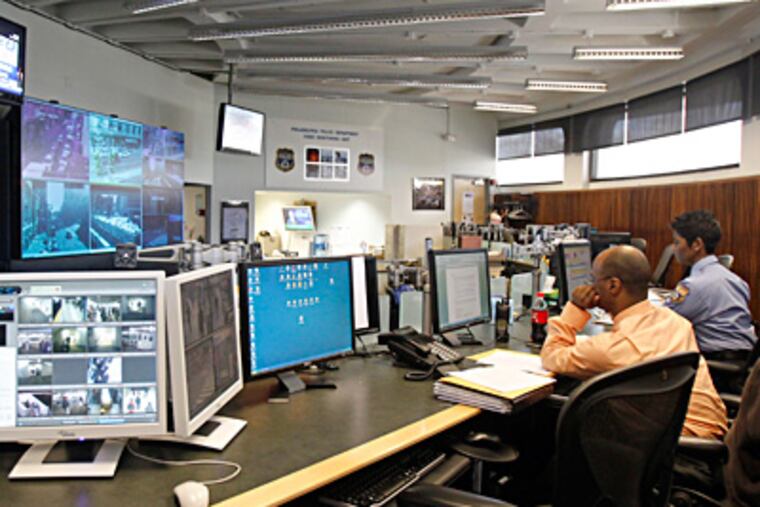Philadelphia police now have 24-hour real-time surveillance center
These days, when Philadelphia police officers respond to robberies and shootings, they might learn that video surveillance from the scene has already been pulled from cameras in the area.

These days, when Philadelphia police officers respond to robberies and shootings, they might learn that video surveillance from the scene has already been pulled from cameras in the area.
Officers in neighborhoods known for car thefts, meanwhile, might be handed an automatic license-plate reader that can scan thousands of vehicles within a few hours.
And in the future, the half hour it might take to conduct database searches for criminal records and other information could be cut to 30 seconds.
It hasn't happened overnight, but the Philadelphia Police Department is making advances in updating its technology. Philadelphia is now one of about 10 cities in the country with a Real-Time Crime Center, a 24-hour hub of video surveillance, databases, and other resources. The center is funded largely with federal money.
The center, which went to 24-hour staffing last month, was developed as a way for officers to assist investigators from a tactical perspective by quickly accessing information about crimes, identifying potential suspects, and even heading off crimes.
The center, overseen by Capt. Joseph McDowell, has been developing in phases for at least two years, and has been in the works for more than four. The team of officers who staff the center said it was already streamlining some aspects of police work.
"It's a work in progress, but it's definitely a step in the right direction," Philadelphia Detective Brian Klak said. "This is providing us with a way to make investigations move faster."
Housed off the lobby of police headquarters at Eighth and Race Streets, the center is equipped with a row of computers and a large wall screen onto which images from cameras around the city are projected.
Officers at the center see every 911 call that comes in and can pull up camera images from crime scenes immediately. Then, when officers respond, the center might already have video footage that shows which way a perpetrator ran, or what a shooter looked like.
"The goal is to speed up an investigation," Klak said. "To give the officers a head start when they get to the scene."
In addition to the city's network of cameras, officers have access to SEPTA's surveillance system. Earlier this month, when a man was robbed at a station on the Broad Street Line in South Philadelphia, officers at the center were able to grab a clear picture of the robber's face as he ran off.
The Police Department has acknowledged that the city's surveillance network is far from perfect and that on any given day many cameras might not be functioning. City officials have pledged to improve the system, and the department has also launched SafeCam, a way for private owners to register their cameras so police can access them in the event of a crime.
Patrol officers are also working with the center to recover more stolen cars using high-tech automated license-plate readers, which can scan plates on vehicles going as fast as 140 miles per hour.
"If you're anywhere in the line of sight, you're going to get scanned," Sgt. Odell Kyler said. "It's almost impossible to go too fast for them."
The readers, which look almost like a camera, use infrared light to scan the tags of passing cars. That information is instantly compared with a nationally compiled list of stolen cars that also includes vehicles used in Amber Alerts and other crimes.
That information is transmitted to the officers in the center, who then confirm whether a car is still registered as stolen. While officers in the field await confirmation, they can follow the car in question at a distance, Kyler said, then pull it over in a safe place.
In any given week, the devices can read as many as 400,000 plates. They have been on the streets for about a month, and officers have recovered 50 stolen cars.
"For an officer, it has the benefit of drawing your attention to something that you would have no reason to notice otherwise," Klak said.
The center, which will not be fully operational until later this year, is also developing a major database that will combine the search functions of several databases. Officers currently must use different systems to search for criminal records, outstanding warrants, and other information - a process that Klak said could take up to a half hour. Once the new system is running, he said, conducting a thorough search should take under a minute.
"The faster you can run database checks, the more time you have to interview suspects, talk to victims, and everything else you have to do," he said. "Years ago, I remember thinking, 'I wish there was an easier way.' "